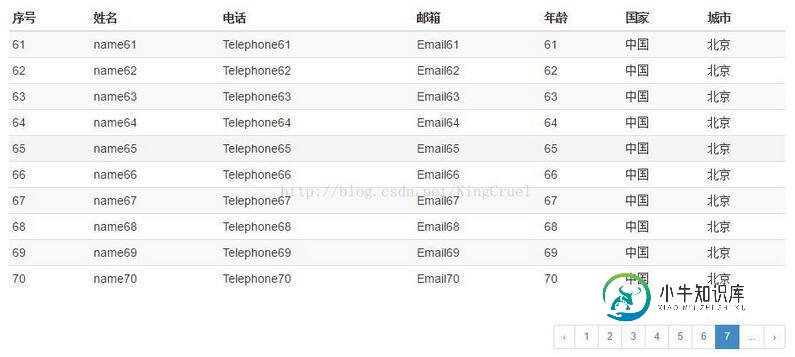Angular ui.bootstrap.pagination分页
本文实例为大家分享了Angular 分页的具体代码,供大家参考,具体内容如下
1、Html
<!DOCTYPE html>
<html>
<head>
<meta name="viewport" content="width=device-width" />
<title>MyPagination</title>
<link href="//netdna.bootstrapcdn.com/bootstrap/3.0.3/css/bootstrap.min.css" rel="stylesheet" />
<script src="~/Scripts/angular.js"></script>
<script src="~/Scripts/ui-bootstrap-tpls-0.13.0.min.js"></script>
<script>
var readyDataUrl = '@Url.Content("~/StudentManage/GetPageList")';
var loadDataUrl = '@Url.Content("~/StudentManage/GetPageList")';
var app = angular.module('app', ['ui.bootstrap']);
app.controller('ctrl', ['$log', '$http', '$scope', function ($log, $http, $scope) {
$scope.reportData = [];
$scope.maxSize = 7;
$scope.currentPage = 0;
$scope.totalItems = 0;
$scope.pageChanged = function () {
//showLoading("正在查询");
$http.post(loadDataUrl, {
pageIndex: $scope.currentPage,
pageSize: 10,
name: ""
})
.then(function (result) {
$scope.reportData = result.data.Data;
$scope.totalItems = result.data.recordTotal;
}).catch(function (error) {
$log.error('error:' + error);
}).finally(function () {
//closeLoading();
});
}
$scope.Inital = function () {
//showLoading("正在查询");
$http.post(readyDataUrl, {
pageIndex: $scope.currentPage,
pageSize: 10,
name: ""
}).then(function (result) {
$scope.reportData = result.data.Data;
$scope.totalItems = result.data.recordTotal;
//closeLoading();
}).catch(function (error) {
$log.error('error:' + error);
}).finally(function () {
});
}
$scope.Inital();
$scope.search = function () {
//showLoading("正在查询");
$http.post(loadDataUrl, {})
.then(function (result) {
$scope.reportData = result.data.Data;
$scope.totalItems = result.data.recordTotal;
}).catch(function (error) {
$log.error('error:' + error);
}).finally(function () {
//closeLoading();
});
}
}]);
</script>
</head>
<body>
<div ng-app="app" ng-controller="ctrl">
<div class="form-group" id="toolbar">
<table>
<tr>
<td style="padding-left:10px;">
<button type="button" class="btn btn-success btn-sm" id="btnSearch" ng-click="search()">查询</button>
</td>
</tr>
</table>
<div class="bootstrap-table">
<div class="fixed-table-container" style="padding-bottom: 0px;">
<div class="table-responsive">
<table class="table table-condensed table-hover table-striped">
<thead>
<tr>
<th><div class="th-inner">序号</div></th>
<th><div class="th-inner">姓名</div></th>
<th><div class="th-inner">电话</div></th>
<th><div class="th-inner">邮箱</div></th>
<th><div class="th-inner">年龄</div></th>
<th><div class="th-inner">国家</div></th>
<th><div class="th-inner">城市</div></th>
</tr>
</thead>
<tbody>
<tr ng-repeat="o in reportData">
<td><span ng-bind="o.Id"></span></td>
<td><span ng-bind="o.Name"></span></td>
<td><span ng-bind="o.Telephone"></span></td>
<td><span ng-bind="o.Email"></span></td>
<td><span ng-bind="o.Age"></span></td>
<td><span ng-bind="o.Country"></span></td>
<td><span ng-bind="o.City"></span></td>
</tr>
</tbody>
</table>
</div>
</div>
</div>
<pagination class="pagination-sm pull-right"
ng-model="currentPage"
total-items="totalItems"
max-size="7"
ng-change="pageChanged()"
force-ellipses="true"
num-pages="numPages"
boundary-link-numbers="true"
boundary-links="false" @*是否显示第一个/最后一个按钮*@
rotate="false"
previous-text="‹"
next-text="›">
</pagination>
</div>
</div>
</body>
</html>
2、Action
[HttpPost]
public JsonResult GetPageList(int pageIndex, int pageSize, string name)
{
int pageCount = 1;
int recordTotal = 0;
int topRecordTotal = 0;
List<Students> list = new List<Students>();
try
{
list = svc.GetAllStudent();
recordTotal = list.Count();
pageCount = (int)Math.Ceiling((decimal)recordTotal / pageSize);
topRecordTotal = (pageIndex - 1 < 0 ? 0 : pageIndex - 1) * pageSize;
list = list.Skip(topRecordTotal).Take(pageSize).ToList();
}
catch (Exception)
{
throw;
}
return Json(new
{
pageIndex = pageIndex,
pageCount = pageCount,
recordTotal = recordTotal,
Data = list,
}, JsonRequestBehavior.AllowGet);
}
效果图:

以上就是本文的全部内容,希望对大家的学习有所帮助,也希望大家多多支持小牛知识库。
-
主要内容:逻辑地址到物理地址的转换纯粹的分段并不是很流行,并没有被许多操作系统所使用。 但是,分段可以与分页结合使用,以从两种技术中获得最佳功能。 在分段的分页中,主存储器被分成可变大小的段,它们被进一步分成固定大小的页面。 页面比分段小。 每个段都有一个页表,这意味着每个程序都有多个页表。 逻辑地址表示为分段号(基地址),页码和页面偏移量。 分段号 → 它指向相应的分段号。 页码 → 它指向分段中的确切页面。 页面偏移 → 用作
-
分页: 用户程序的地址空间被划分成若干固定大小的区域,称为“页”,相应地,内存空间分成若干个物理块,页和块的大小相等。可将用户程序的任一页放在内存的任一块中,实现了离散分配。 分段: 将用户程序地址空间分成若干个大小不等的段,每段可以定义一组相对完整的逻辑信息。存储分配时,以段为单位,段与段在内存中可以不相邻接,也实现了离散分配。 分页与分段的主要区别 页是信息的物理单位,分页是为了实现非连续分配
-
分页与分段比较,如下表所示 - 编号 分页 分段 1 非连续的内存分配 非连续的内存分配 2 分页将程序分成固定大小的分页。 分段将程序分成可变大小的段。 3 由操作系统负责 由编译器负责。 4 分页比分段更快 分段比分页慢 5 分页更接近操作系统 分段更接近用户 6 它会遭受内部碎片问题 它会遭受外部碎片问题 7 没有外部碎片 没有外部碎片 8 逻辑地址分为:页码和页码偏移 逻辑地址分为:分段号
-
本文向大家介绍thinkphp3.2.3 分页代码分享,包括了thinkphp3.2.3 分页代码分享的使用技巧和注意事项,需要的朋友参考一下 对于thinkphp分页的实现效果,两种调用方法,一种调用公共函数中的函数方法(参考http://www.cnblogs.com/tianguook/p/4326613.html),一种是在模型中书写分页的方法 1、在公共函数Application/C
-
Django提供了一些类来帮助你管理分页的数据 -- 也就是说,数据被分在不同页面中,并带有“上一页/下一页”标签。这些类位于django/core/paginator.py中。 示例 向Paginator提供对象的列表,以及你想为每一页分配的元素数量,它就会为你提供访问每一页上对象的方法: >>> from django.core.paginator import Paginator >>> o
-
当一次要在一个页面上显示很多数据时,通常需要将其分成几部分, 每个部分都包含一些数据列表并且一次只显示一部分。这些部分在网页上被称为分页。 Yii 使用 yii\data\Pagination 对象来代表分页方案的有关信息。特别地, total count 指定数据条目的总数。 注意,这个数字通常远远大于需要在一个页面上展示的数据条目。 page size 指定每页包含多少数据条目。 默认值为 2
-
简介 在 Linux 内核启动过程中的第五部分,我们学到了内核在启动的最早阶段都做了哪些工作。接下来,在我们明白内核如何运行第一个 init 进程之前,内核初始化其他部分,比如加载 initrd ,初始化 lockdep ,以及许多许多其他的工作。 是的,那将有很多不同的事,但是还有更多更多更多关于内存的工作。 在我看来,一般而言,内存管理是 Linux 内核和系统编程最复杂的部分之一。这就是为什
-
数据库查询时可以直接用 Db 的 paginate 方法 // 查询状态为1的用户数据 并且每页显示10条数据 $users = Db::name('user')->where('user_status',1)->paginate(15); // 把分页数据赋值给模板变量users $this->assign('users', $users); $this->assign('page', $use

